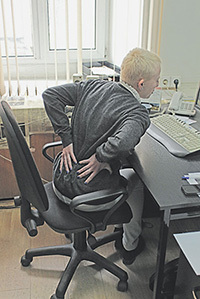
Back pain, lower back pain – there is no person who would never in her life experienced. According to the world health organization, is the most common complaint and the most frequent cause of temporary disability.
What to do?
Phenomena of degenerative changes of the spine are often referred to as the outdated term "osteochondrosis". These phenomena are observed among the majority of people over 18 years old. By itself, the word "osteochondrosis" includes anything from age norm to very severe pathology. This term reluctantly used by most neurosurgeons, and is not used in the international literature.
Back pain can be a separate problem ("grab", "gelidus back", etc.), but may indicate disease of the spine, about a variety of serious conditions, from pyelonephritis and flu, spinal tumors or metastases in the vertebrae. Thus, back pain is a symptom that requires diagnosis.
By far the diagnosis for back pain are necessary in the following cases: the pain came after the injury, falls, accidents; severe pain lasts a few days, stopping to walk and/or sleep; pain radiates to the foot/leg (buttock, thigh, Shin/calf and foot); torpor, sensation of pins and needles in the foot/feet; reducing the force in any part of the feet/legs; weight loss feet/legs; difficulty or frequent urination, bowel movements; severe pain in an older person; in severe back pain in macie, weakened or a person with a temperature; with back pain in a patient with severe systemic disease, such as osteoporosis, cancer, tuberculosis.
Clearly the desire to find out why a sore lower back. Best to start with magnetic resonance imaging (MRI) of the lumbosacral spine. All other actions, including a visit to the doctor, then. On the MRI you will have to spend a few thousand, but to do without a doctor's referral.
The conclusion, written by a specialist in radiodiagnostics, often scares the patient. It can be written: hernia / protrusion / stenosis / degenerative disc disease / herniated Smorlya / spondylosis. It can mean anything, including nothing. Just describe the Mr-phenomena. They should be interpreted by the Clinician with consideration of medical history, diseases, additional research and much more. Conclusion is not written for the patient, and another doctor.
Radiography and computed tomography in the majority of cases, additional studies prescribed by your doctor.
Making an MRI of the lower back, you need to consult a neurologist or neurosurgeon. Second, in my subjective opinion, better: the average neurosurgeons operate much better interpretiruya pictures, because daily I see the real images on the operations and correlate them with MRI and clinical picture. In some cases, about which I will say a neurologist or a neurosurgeon, you need a podiatrist.
If the results of inspection and evaluation MRI is not need surgery (most often the case), the treatment is carried out under the supervision of a neurologist. In typical cases this includes nonsteroidal anti-inflammatory drugs, muscle relaxants and other medications. Sometimes other methods are required. To determine the manner and duration of treatment can only a doctor.
Self-treatment of lower back pain, especially without an MRI, an extremely unwise move. The use of alternative medicine, again – especially without an MRI, total idiocy.
Sometimes the doctor says that you need to remove the herniated disc. Thanks to the use of endoscopic and microsurgical techniques in the right hands this operation is quite safe. I usually tell patients that the risk of paralysis or other serious complications when removing a disc herniation is approximately equal to the risk of death in a traffic accident on the way to counseling.
Many fear that the surgery on the spine can paralyze. It is almost impossible. There are dangerous operations associated with this risk, for example the removal of intramedullary tumors, surgery for fractures of the thoracic spine etc. If there is such a danger, it warned. When you remove the disc herniation, the resolution of the stenosis of the spinal canal, the risk of these complications theoretical. Condition security is a qualified neurosurgeon and the clinic has modern equipment.
There are diseases that require stabilization of the spine – the installation of structures that hold the vertebrae with each other. Stabilization methods and systems to stabilize very much. Stabilization of the spine is performed only on strict indications. The need for it can only define a neurosurgeon. Most often stabilizing surgery is needed when spinal stenosis, spondylolisthesis, instability of vertebral segments, the vertebral fractures.
After most operations on the spine not only do not have long to lie, but often the patient begins to walk alone the next morning after surgery or even in the evening on the day of surgery.
What you need to do, not to hurt the lower back? In private hospitals you can find commercial programs to combat back pain at the cost of the car. It is scientifically proven that in fact is enough the basic things.
First of all you need to be in the normal range of body weight, others. You should have a well-developed axial muscles – swimming and fitness. Finally, back pain is a frequent first symptom of depression because depression is accompanied by decreased pain threshold. In General, it is necessary to have a normal mood and keep in shape.

























